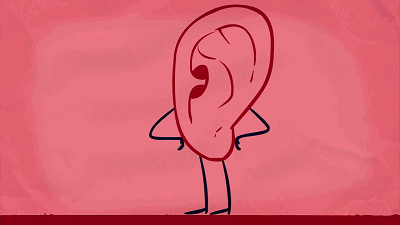
Motion sickness is a kind of suffering that no one else can experience.
For these people, a trip ends from the moment they take the transportation. I met a driver who likes to slam the brakes, and can vomit several times along the way.

Why are there people who get motion sickness, air sickness, or seasickness?
Why do people get motion sickness, air sickness, or seasickness?
Motion sickness is a kind of motion sickness. This phenomenon is caused by any form of acceleration (deceleration) movement, such as bumps, swings and rotations generated by the movement of cars, ships or airplanes, which stimulate the vestibular nerve of the human body.
The main symptoms include headache, dizziness, nausea, vomiting, acid regurgitation, increased saliva secretion, and sweating.

(Reminder: do not look at it for too long or you will be dizzy!)
The human ear is not only used to listen to sound, but also has vestibular receptors in the inner ear that are responsible for the balance of the body. Factors such as odor, ventilation, and turbulence will affect the vestibular organs.
The root cause of motion sickness is that the signals transmitted by the human body’s receptors and vestibular organs to the brain through the human central nervous system are inconsistent, resulting in dizziness.

For example, when riding in a car, the vestibular receptors send the information that the body is moving along with the car to the brain, but the scene seen by the eyes is static. This inconsistent information will obviously make the brain confused. If the brain cannot handle it in a short period of time, it will issue motion sickness commands.
Why is it more likely to feel dizzy when sitting in the backseat?
When a person sits in the front seat, the field of vision is relatively open. As the car is moving, our body also feels bumps up and down.
The result is that the vestibular receptors of the ears and the vision that our eyeballs see are basically consistent with the information transmitted to the brain, so it is not easy to get motion sickness when sitting in the front seat.

When sitting in the back seat of the car, we cannot guarantee a wide field of vision.
When the balance receptors in the ears are adapting to the speed of forward movement, the eyes do not have enough vision to determine whether they are moving or stationary.
At this time, if your eyes are fixed on objects inside the vehicle (for example, when you lower your head to play with your mobile phone), your brain will receive a “no movement” signal, causing the vestibular receptors and brain information to be out of sync, and dizziness will occur.
What will make motion sickness more severer?
People who are prone to motion sickness should try to avoid the following behaviors when taking transportation. Otherwise, dizziness may be more severer.
Reading books and playing cell phone while riding in the car
Reading a book, playing mobile phone while riding in a car, and quickly swaying objects outside the window will increase the stimulation to the vestibule.
Looking to the left and right
If we look to left or right side when the car is moving forward, the ears and brain just form a wrong angle with the forward direction. Maintaining this posture for a long time will cause adverse reactions.
Air tight carriage
The airtight compartment prevents air circulation, or the smell of gasoline is heavy, which will cause discomfort and increase the chance of motion sickness.
Sudden braking
If the driver drives the car very hard, fast, shakes the car too much, or stops abruptly, it is easy to aggravate motion sickness.
Status when riding in a car
You are prone to motion sickness when you are too hungry or full, or when you have poor sleep or overwork.
6 ways to reduce dizziness
Motion sickness is not only related to the vestibular organs of the human body, but also related to the visual control system, hearing perception system, and olfactory perception system.
To reduce the symptoms of vertigo, you can try the following methods:

01. Keep your eyes on the front
The picture seen in the eyes is moving, so when we ride in the car, we will know what driving action the driver will do next, and the balance receptors are also consistent with the situation felt by the visual organs. This will prevent motion sickness.
02. Maintain ventilation in the car
Relieve motion sickness by adjusting people’s sense of smell. When you feel bored, open the windows for ventilation, or stop and get out of the car and walk around. Do not put pungent perfumes, sachets and other items in the car.
03. Try to sit in the front seat
The vision in the back seat is poor. When the balance organs in the ears are adapting to a movement, the eyes cannot determine whether they are moving or stationary, and motion sickness is more likely to occur.
04. Divert attention
Use listening to music, chatting or sleeping to divert attention, but don’t look at the phone or read a book. Try not to eat snacks while driving.
05. Smell the fresh orange peel
Fold the fresh orange peel (grapefruit peel, orange peel) surface outwards and inward, and then squeeze it with your fingers against the two nostrils. A fragrant oil mist will be sprayed from the peel.
06. Drug prevention
Taking motion sickness medicine, you need to choose the right time according to the type.
For short-distance driving (within 3 to 4 hours), it is recommended to use Zolpidem or Zopiclone, which has a fast onset of action and a short action time. It can be taken 10 minutes before getting on the bus.
For longer-term travelers (such as a ten-hour flight), it is recommended to use diazepam, a long-term drug. It needs to be taken 30 minutes before boarding.
For most people with motion sickness, the most common adverse reaction after taking motion sickness drugs is drowsiness. This situation belongs to the normal pharmacological effects of the drug. There is no need to worry. When the drug is excreted by the body, the discomfort will subside.
Comments